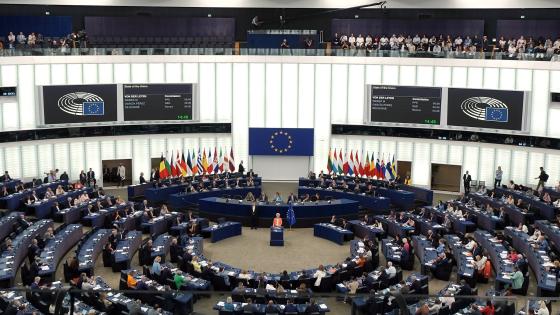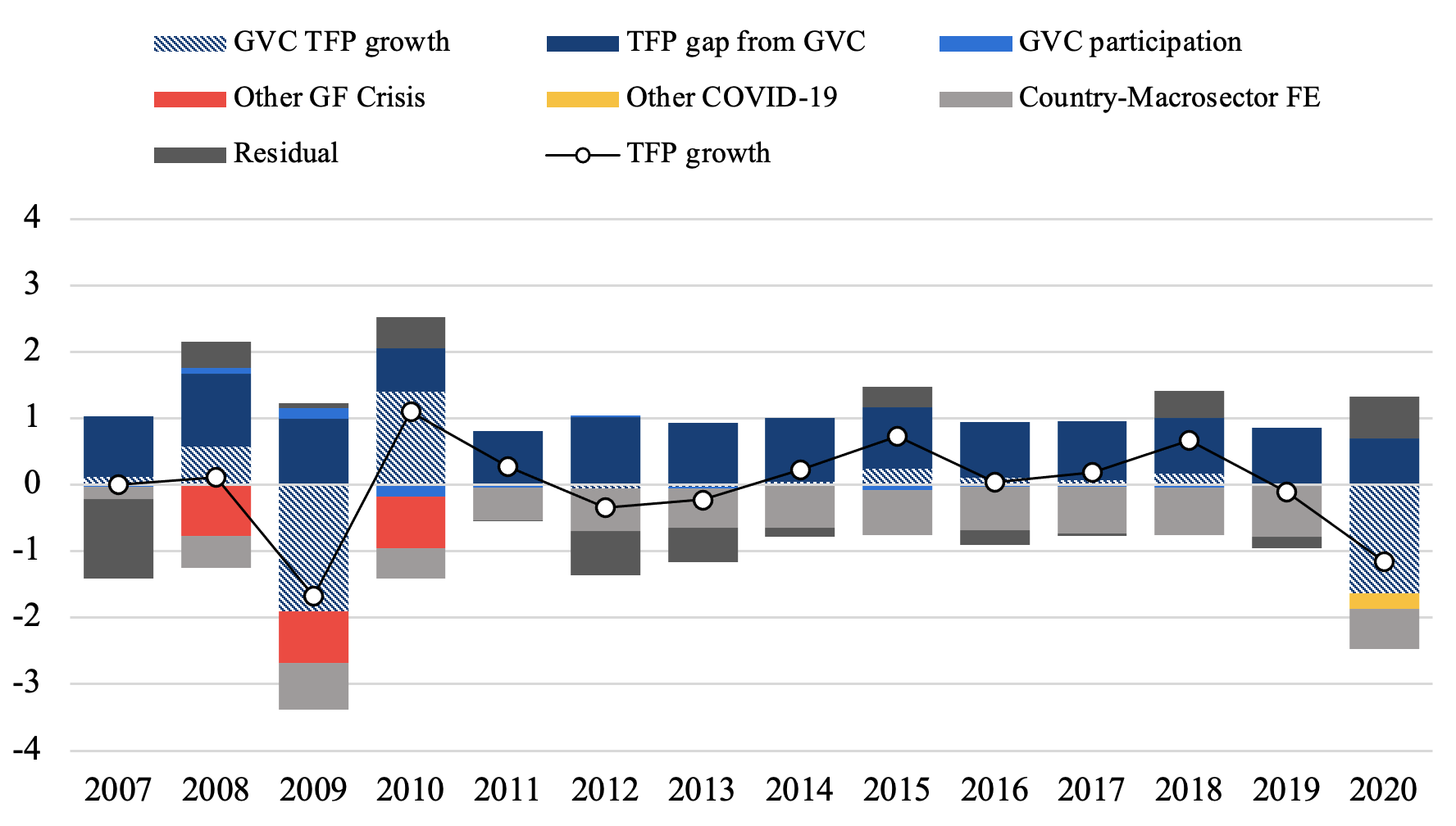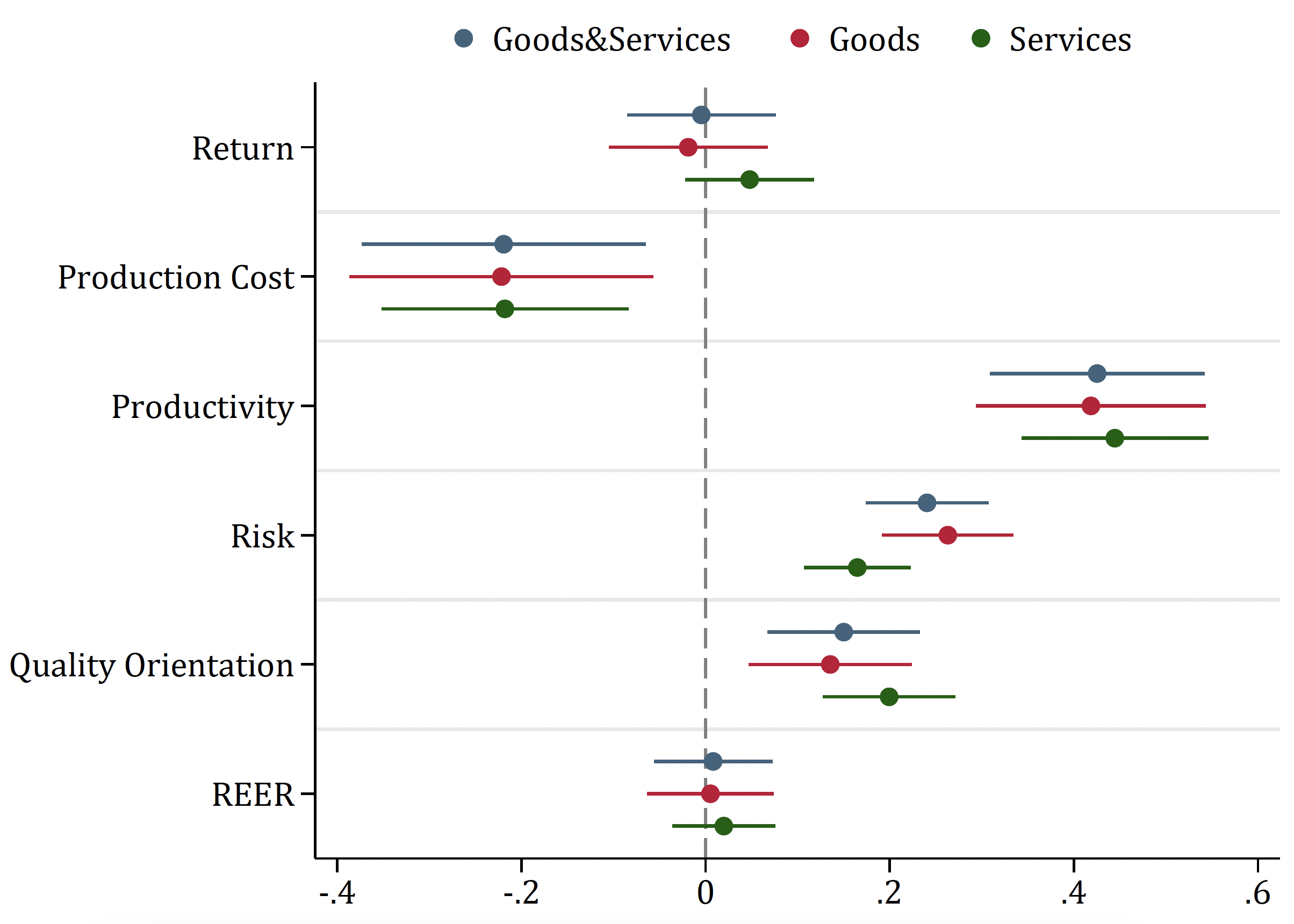Ursula von der Leyen strategically elevated the issue of competitiveness within Europe in her recent State of the Union address, and rightly so.
The pursuit of enhanced competitiveness necessitates a more efficient utilisation of resources, ultimately leading to an increased productivity within the broader economic system. Unfortunately, Europe's track record in this regard is disheartening, demanding urgent attention and action. The most recent data from CompNet underscores the persistent stagnation of total factor productivity (TFP) in Europe over the past two decades, with negative fluctuations during both the 2009 Global Financial Crisis (GFC) and the COVID-19 pandemic in 2020.
Delving into some of the root causes, in this column we examine external factors and conclude that China was not the problem. Instead, our analysis leans towards internal challenges, notably the profound negative impact of within-EU global value chain (GVC) operations during times of crisis. This phenomenon has occurred against the backdrop of an overarching sluggishness in productivity (detailed in the next section).
Within the spectrum of drivers influencing overall competitiveness, our focus identifies productivity and innovation content as pivotal components (expounded upon below). By acknowledging and addressing these internal challenges, Europe can pave the way for a more robust and competitive economic landscape.
The role of EU global value chains
To do so, we examine how the TFP of European firms is affected by their external environment, particularly via the conduit of the GVCs to which they are connected.
Drawing from Bertelsman et al. (2008) as well as Chiacchio et al. (2018), we disentangle productivity transmission inside GVCs stretching within EU borders, within two phases. In a first phase, an external productivity shock (e.g. an invention on the positive side or a sudden supply disruption on the negative side) has an immediate impact on the frontier (i.e. most productive) firms, which are directly connected via trade flows to the respective GVC. In a second phase, after a learning process, productivity gains trickle down from the national frontier to other national firms through domestic production networks.
To measure such impacts, we link CompNet data on firms’ productivity with their respective trade linkages as reported by the OECD Inter-Country Input-Output (ICIO) tables. The productivity of each country and macro-sector is the employment-weighted average of laggard, frontier, and average firms (firms in the bottom 20%, top 20%, and intermediate deciles, respectively, of the productivity distribution of each country and macro-sector).
Hence, we aim to capture the following contributions to the TFP growth rates of each country and macro-sector each year:
- The transmission of TFP rates of change from the respective GVC frontier (i.e. from the average TFP growth rate across foreign countries and macro-sectors that import from the given country and macro-sector).
- The ‘catch-up’ effect – whether being more distant from the GVC frontier (in terms of a labour productivity gap) benefits TFP growth of national firms.
- Overall GVC participation (increases in percentage points of exports over output from one year to the other).
- Separately, other COVID and GFC shocks.
- Time-invariant features of each country and macro sector.
- Time-varying unexplained factors affecting TFP growth (on top of systemic COVID and GFC shocks).
The results (see Figure 1) are as follows.
Figure 1 Contributions to EU TFP growth rates within EU global value chains
Source: CompNet 9th Vintage (jd_inp_prod_industry2d_20e_weighted) and OECD ICIO.
Note: Figures are yearly averages across countries and macro-sectors weighted by real value added. Results for export linkages between BE, CH, CZ, DE, DK, ES, FI, FR, HR, HU, IT, LT, LV, MT, NL, PL, PT, RO, SI, SK, and SE. Unbalanced sample over 2005-2020. The latest available year is 2018 for DE, and 2019 for LV and NL.
- As expected, the TFP growth of the EU GVC counterparts (the dashed blue histogram) has a rather strong impact on the TFP of the economy as it directly affects the frontiers firms connected to them.
- What is notable is that such impacts become very strongly negative at the time of crisis (see the large negative histogram in 2009 and 2020).
This is reminiscent of evidence of an additional burden from COVID on European firms in GVCs (Lebastard et al., 2023), and its sources – which may trace back to elements such as inventory management (Lafrogne-Joussier et al. 2022), prevalence of arm’s-length rather than intra-group transactions (Altomonte et al. 2012), or risk misperception (Baldwin and Freeman 2022) – deserve further investigation.
- The most positive contribution to aggregate TFP growth, however, comes from the productivity gap of the various countries and macro-sectors with respect to their respective within-EU GVC counterparts. The intuition is that when this gap is large, there is possibly a Balassa-Samuelson kind of ‘catching-up effect,’ which could be activated.
- On the other hand, and paradoxically given the current debate, the residual, which would include the China effect together with the remaining time-varying omitted factors, has a small and often actually positive contribution to the TFP growth.
Overall, it would seem therefore that the shock that is internal to EU GVCs (i.e. European firms trading with other European firms) may be more relevant in explaining TFP growth fragility amidst crises and generalised sluggishness (the always negative ‘country-macro-sector FE’) than any residual Chinese one.
Drivers of external competitiveness
The 2023 State of the Union speech neatly advocated for true and fair competition. It also stated that European companies recognise global competition being good for business and a pivot to create and protect good jobs in Europe. In this context, ‘predatory’ practices benefitting competitors and marginalising European firms on foreign markets have been stigmatised. An anti-subsidy investigation into electric vehicles coming from China was also announced.
Nurturing a vibrant competitive environment requires policymakers to identify those aspects that are most relevant for sound firm performance (di Mauro and Forster 2008, Karadeloglou et al. 2015). Building on previous work by Amador et al. (2022) and Lourenço et al. (2022), and in collaboration with a team at the Portuguese Gabinete de Estratégia e Estudos (GEE), we built a novel micro-aggregated composite indicator using CompNet data. Our version of the Enterprise Competitiveness Indicator (ECI) considers five dimensions of performance – returns, costs, productivity, risks, and quality orientation (CompNet 2023: 29-34) – for the average firm in each country. When putting it to work, the ECI seems to offer insights into the drivers of EU firms’ demeanour on global markets (Figure 2).
Figure 2 ECI by dimension, REER, and export market shares
Source: CompNet 9th Vintage (unconditional_mac_sector_20e_weighted) and Eurostat
Note: Coefficients from regressing market shares on ECI dimensions (pooled, each computed like in CompNet, 2023 pages 29-34) and Eurostat real effective exchange rates (REERs) with year fixed effects. REERs are the nominal effective exchange rates (NEERs) for 42 trading partners deflated by consumer price indices (CPIs). Results for BE, CZ, DE, DK, ES, FI, FR, HR, HU, IT, LT, LV, MT, NL, PL, PT, RO, SI, SK, and SE. The latest available years are 2019 for LV and NL, and 2018 for DE.
Our results suggest that productivity, financial soundness (risk), and quality orientation correlate with higher EU countries’ export market shares more often than profitability (return) and, even more strongly, production costs. Also exchanges rates appear scarcely related to trade developments (see Grazioli et al., 2016 for further on this). Intuitively, this correlational evidence may point to European exporters being specialised in more downstream, higher value-added stages of value chains (e.g. Bontadini et al. 2021). If so, curbing artificial low prices would speak only less directly to the competitiveness of EU firms, while other factors appear more in tune with navigating international competition on those markets where the EU comparative advantages are stronger.
Conclusions
It is encouraging to see competitiveness taking a prominent position on the EU economic agenda. However, it is crucial to make well-informed decisions regarding the areas we prioritise for improvement. In this column, we have presented evidence suggesting that there are critical internal factors within the EU that, if effectively leveraged, can significantly boost the productivity of firms and ultimately bolster their global competitiveness.
First and foremost, the GVCs operating within Europe exert a substantial influence on the overall productivity of the continent. They have a direct impact on the leading firms connected to them. Therefore, it is imperative to strengthen the resilience and robustness of these GVCs.
Furthermore, there still exist significant disparities between the most advanced and less advanced firms within the EU. These disparities create a potent incentive for ‘catching-up’ efforts, which in turn contribute positively to the overall productivity of Europe. In contrast, the influence of GVCs located outside of Europe, including China, appears to be somewhat limited in its impact on European productivity, albeit mostly positive.
When we examine the determinants of export market shares for EU firms, our analysis reveals that productivity, financial stability (risk management), and a focus on quality are the primary factors at play. Instead of resorting to broad import controls, it is prudent to direct our attention towards enhancing these aspects. It is highly likely that these measures will be instrumental in maintaining and even elevating the EU’s competitive advantage on the global stage.
References
Altomonte, C, F di Mauro, G Ottaviano, A Rungi and V Vicard (2012), “Global value chains are not all born identical: Policymakers beware”, VoxEU.org, 4 January.
Amador, J, A Fernandes and G Nogueira G (2022), “The competitiveness of the Portuguese economy: A view from a composite indicator”, Banco de Portugal Economic Studies VIII: 29–54.
Baldwin, R and R Freeman (2022), “Global supply chain risk and resilience”, VoxEU.org, 6 April.
Bartelsman, E J, J Haskel and R Martin R (2008), “Distance to which frontier? Evidence on productivity convergence from international firm-level data”, CEPR Discussion Paper 7032.
Bontadini, F, R Evangelista, V Meliciani and M Savona (2021), “Patterns of integration in global value chains and the changing structure of employment in Europe”, Working Paper 12/2021, Luiss University.
Chiacchio, F, K Gradeva and P Lopez-Garcia (2018), “The Post-Crisis TFP Growth Slowdown in CEE Countries: Exploring the Role of Global Value Chains”, Working Paper Series 2143, European Central Bank.
CompNet (2023), Firm Productivity Report, July.
di Mauro, F and K Forster (2008), “Globalisation and the competitiveness of the euro area”, ECB Occasional Paper 97.
Grazioli, M, S De Pinto, F di Mauro and K Benkovskis (2016), “Fighting ‘currency wars’ with blanks: The limited role of exchange rates in export competitiveness”, VoxEU.org, 29 June.
Karadeloglou, P, K Benkovskis, G Aiello et al. (2015), “Compendium on the Diagnostic Toolkit for Competitiveness”, Occasional Paper Series 163, European Central Bank.
Lafrogne-Joussier, R, J Martin and I Mejean (2022), "Supply chain disruptions and mitigation strategies”, VoxEU.org, 5 February.
Lebastard, L, M Matani and R Serafini (2023), “Understanding the impact of COVID-19 supply disruptions on exporters in global value chains”, VoxEU.org, 24 March.
Lourenço, M, C Magalhães, F Martins, M C Pereira and H Reis (2022), “Uma análise da competitividade das empresas em Portugal e em alguns países europeus”, Banco de Portugal Occasional Papers.
Miroudot, S (2020), “Resilience versus robustness in global value chains: Some policy implications”, VoxEU.org, 18 June.





